24-3 Quasar accretion disks and jets
Accretion—the capture and consumption of material—by a super-massive black hole is the most likely explanation of the immense energy output of active galactic nuclei. The challenge to astrophysicists is to understand how that accretion takes place. A successful model of the accretion process must also explain other properties of active galactic nuclei, including their unusual spectra, variable light output, and energetic jets.
Accretion Disks around Supermassive Black Holes
The power source for active galaxies is gravitational energy released by material falling toward a central black hole
In the leading model of this process, at the heart of an active galaxy is a supermassive black hole surrounded by an accretion disk, a solar system–sized disk of matter captured by the hole’s gravity and spiraling into it. We saw in Section 18-5 that accretion disks are found around stars in the process of formation. The accretion disks that astrophysicists envision around supermassive black holes are similar but far larger and far more dynamic. The Cosmic Connections: Accretion Disks figure depicts the physics of such accretion disks.
Imagine a billion-solar-mass black hole sitting at the center of a galaxy, surrounded by a rotating accretion disk. According to Kepler’s third law, the inner regions of this accretion disk would orbit the hole more rapidly than would the outer parts. Thus, the rapidly spinning inner regions would constantly rub against the slower moving gases in the outer regions. This friction, aided by magnetic forces within the disk, would cause the gases to lose energy and spiral inward toward the black hole.
As the gases move inward within the accretion disk, they are compressed and heated to very high temperatures. This causes the accretion disk to glow, thus producing the brilliant luminosity of an active galactic nucleus. The temperature of material in the accretion disk reaches 100,000 K or more, which emits thermal radiation primarily at UV and visible wavelengths. (By comparison, the Sun is around 5800 K and the hottest blue stars are around 50,000 K.)
In this model, the fundamental source of the energy output by an active galactic nucleus is gravitational energy converted into, and released as, thermal radiation by infalling material in the accretion disk. We saw in Section 20-6 that gravitational energy is also what powers the immense light output of a core-collapse supernova. The difference between such a supernova and an active galactic nucleus is that the infall of a supernova’s outer layers is a one-time event, while gas in an AGN’s accretion disk spirals inward continuously.
This model of accretion works well for smaller disks such as those around neutron stars or stellar mass black holes. However, as much as it is the favored model, detailed accretion disk calculations for AGN are a poor fit to actual observations. Whether quasars derive their intense luminosity through accretion disks, a more complicated accretion scenario, or some other process is still unknown. Until the emission mechanism for quasars is understood, it is likely to remain on the frontier of modern research.
COSMIC CONNECTIONS
Accretion Disks
Quasars and active galaxies are thought to be powered by gravitational energy released when gas falls toward a central supermassive black hole. Due to conservation of angular momentum, the gas does not fall straight into the black hole. Instead, it must negotiate its way through an accretion disk.
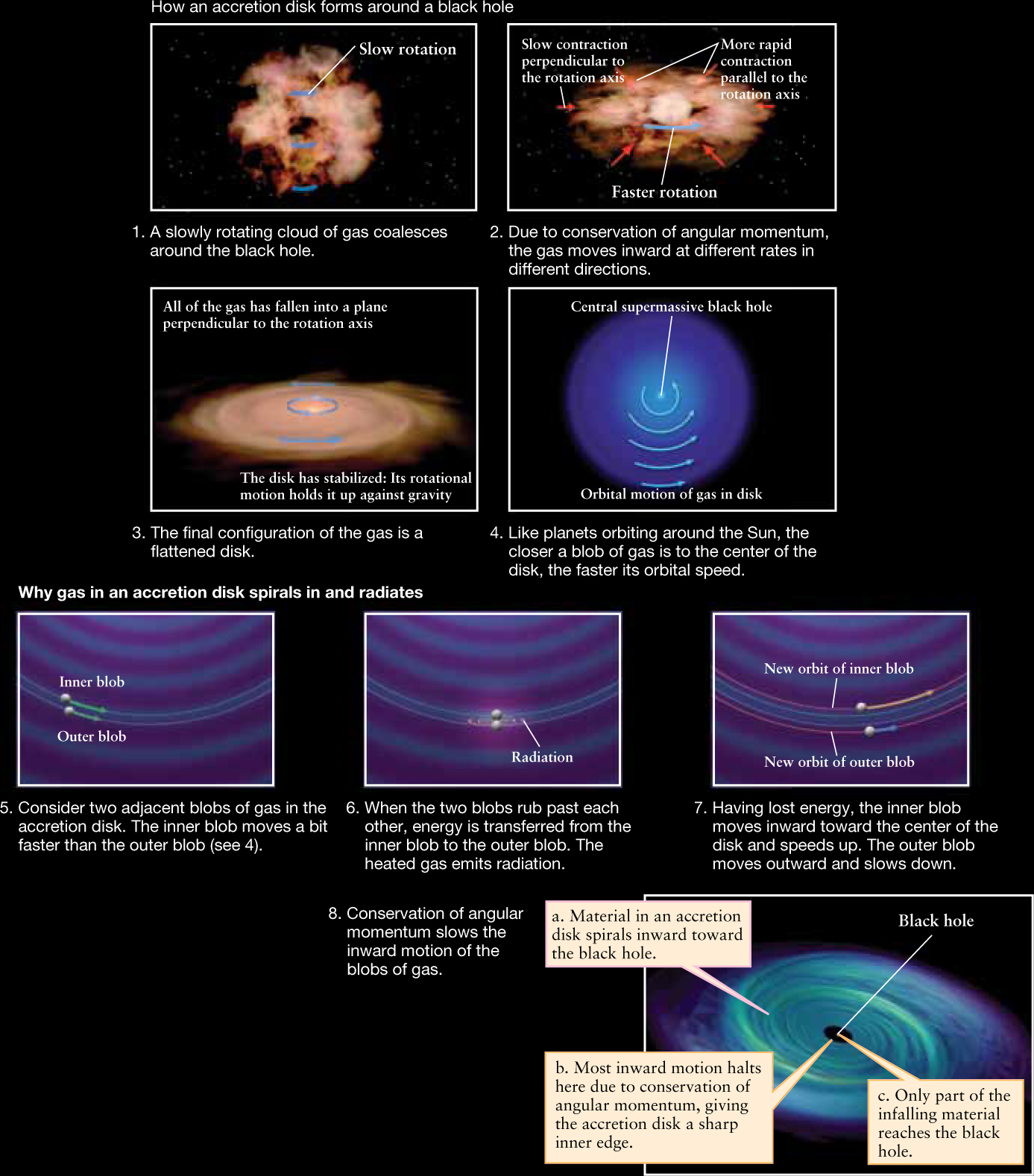
Jets of Charged Particles
Because of the constant inward crowding of hot gas in the plane of the accretion disk, pressures climb rapidly near the center. These pressures expel matter at extremely high speeds. This ejected material escapes at right angles to the plane of the accretion disk and the material forms into two jets (Figure 24-7). However, the active galaxy M87 only shows a single jet. Similar to a flashlight beam, we can clearly see the jet pointed toward us, but the jet pointing away is not visible (Figure 24-8) For AGN, the matter in the jets travels at nearly the speed of light, and this leads to beamed emission that is only visible when pointed somewhat toward the observer.
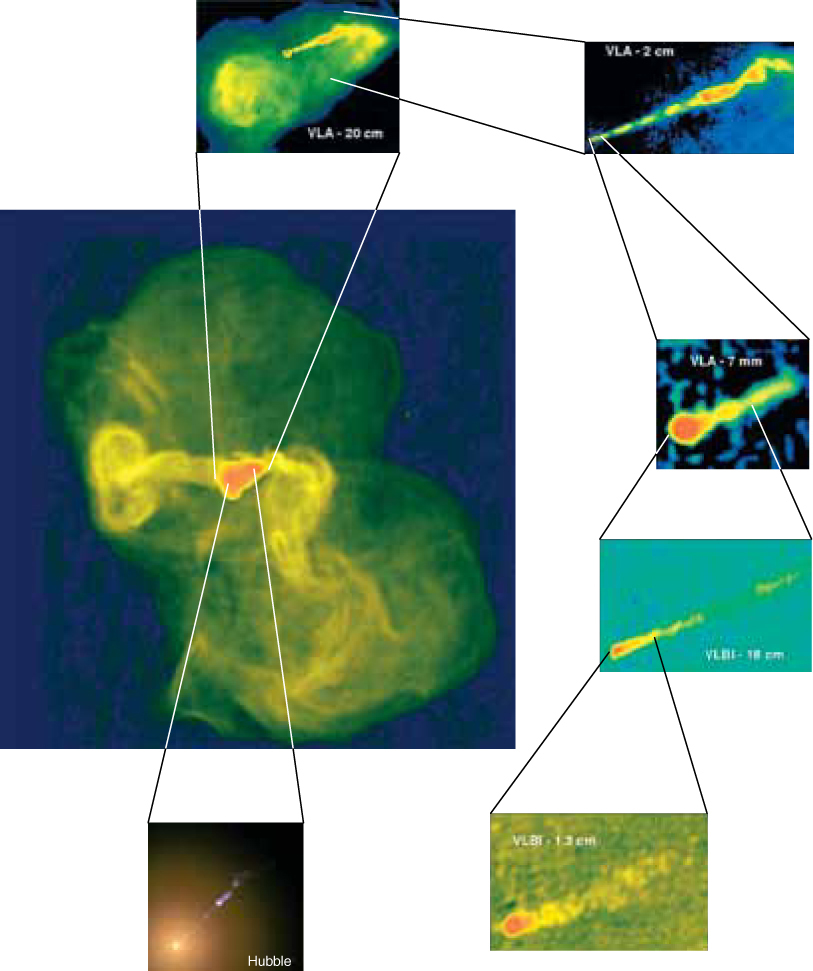
Giant Elliptical Galaxy M87 M87 is located near the center of the sprawling, rich Virgo cluster, which is about 50 million ly from Earth. Embedded in this radio image of gas is the galaxy M87 from which the gas has been ejected (bottom inset). The bottom inset is a visible light image from the Hubble Space Telescope, and the rest are at radio wavelengths. As the images zoom into smaller scales, they reveal a variety of details about the structure of the jets of gas. M87’s extraordinarily bright nucleus and the gas jets result from a 3-billion-M⊙ black hole, whose gravity causes huge amounts of gas and an enormous number of stars to crowd around it.
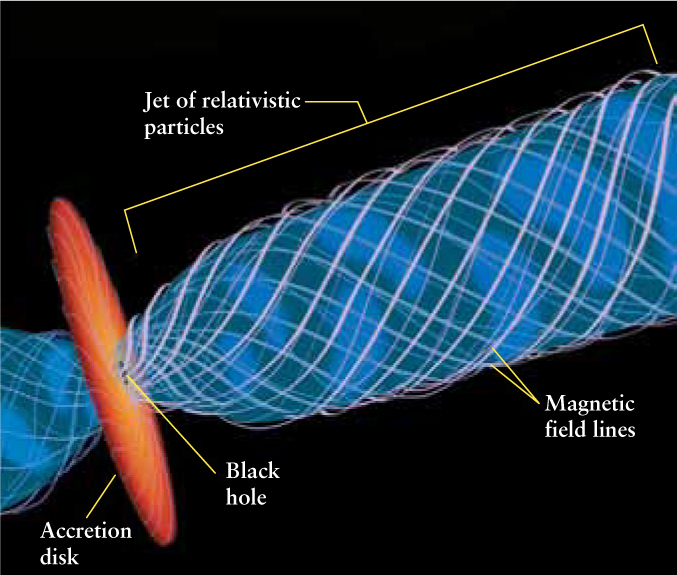
 Magnetic forces play a crucial role in steering these fast-moving particles. These forces arise because the hot gases in the accretion disk are ionized, forming a plasma, and the motions of this plasma generate a magnetic field (see Section 16-9). As the plasma in the disk rotates around the black hole, it pulls the magnetic field along with it. But because the disk rotates faster in its inner regions than at its outer rim, the magnetic field becomes severely twisted. This twisted field forms two helix shapes, one on either side of the plane of the disk.
Magnetic forces play a crucial role in steering these fast-moving particles. These forces arise because the hot gases in the accretion disk are ionized, forming a plasma, and the motions of this plasma generate a magnetic field (see Section 16-9). As the plasma in the disk rotates around the black hole, it pulls the magnetic field along with it. But because the disk rotates faster in its inner regions than at its outer rim, the magnetic field becomes severely twisted. This twisted field forms two helix shapes, one on either side of the plane of the disk.
Charged particles flowing outward from the accretion disk tend to follow these magnetic field lines. The result is that the out-flowing beams of particles are focused into two jets oriented perpendicular to the plane of the accretion disk. The figure that opens this chapter is an artist’s conception of the accretion disk and jets. The highly collimated jets shoot well beyond the host galaxy, and very diffuse gas in the space between galaxies spreads the jets into radio lobes, as in Figure 24-1. Jets are primarily observed at radio wavelengths but some jets can also be seen at visible wavelengths and even X-rays (Figure 24-9). It is not known if the charged particles in jets are composed of electrons and protons, or electrons and their antimatter partners, the positrons.
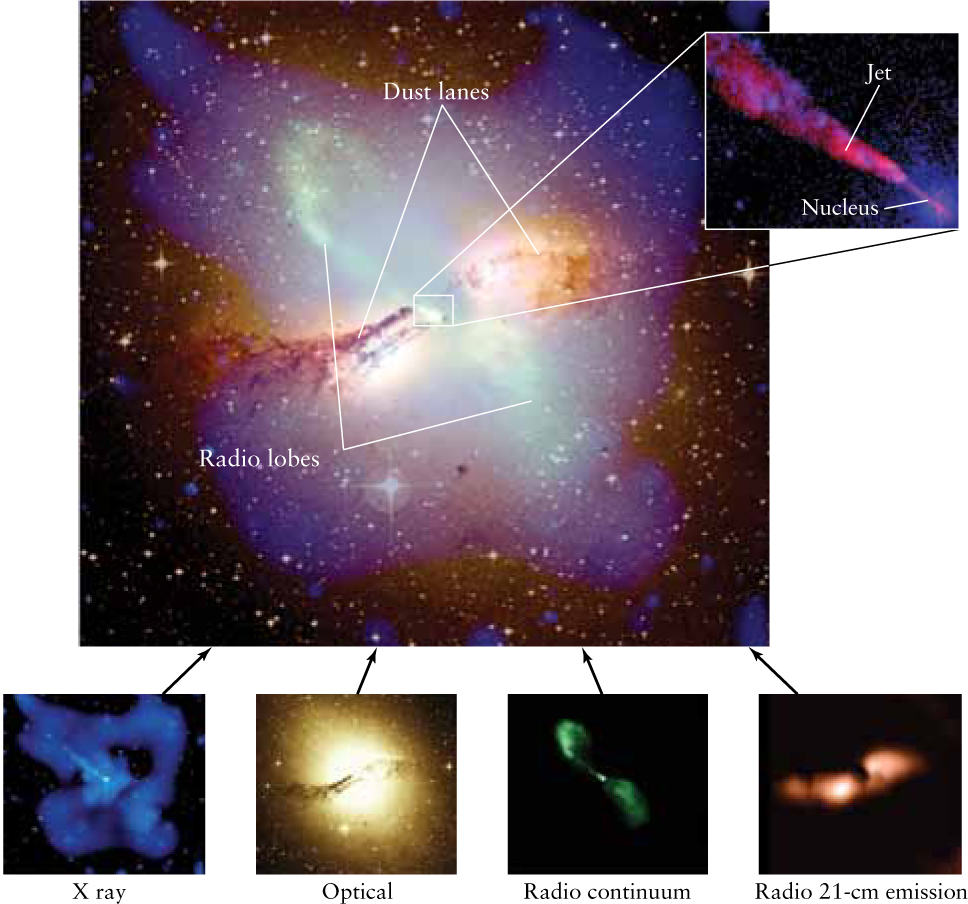
Peculiar Galaxy NGC 5128 (Centaurus A) This extraordinary radio galaxy is located in the constellation Centaurus, 11 million ly from Earth. At visible wavelengths a dust lane crosses the face of the galaxy. Superimposed on this visible image is a false-color radio image (green) showing that vast quantities of radio emission pour from matter ejected from the galaxy perpendicular to the dust lane, along with radio emission (rose-colored) along the dust lane, and X-ray emission (blue) detected by NASA’s Chandra X-ray Observatory. The X-rays may be from material ejected by the black hole or from the collision of Centaurus A with a smaller galaxy. Upper right inset: This X-ray image from the Einstein Observatory shows that NGC 5128 has a bright X-ray nucleus. An X-ray jet protrudes from the nucleus along a direction perpendicular to the galaxy’s dust lane.
CONCEPT CHECK 24-5
In the accretion disk model, what happens when an inner blob of gas passes an outer blob of gas during accretion (see Cosmic Connections: Accretion Disks)? How is light produced in an accretion disk?
Orbits closer to the central mass have higher speeds so that an inner blob rubs against an outer blob in the disk, causing the inner blob to lose energy and spiral inward. Also, as the blobs rub past each other they produce heat. Thermal radiation from this heat produces much of a quasar’s visible light.
The Strange Case of Superluminal Motion
Nothing travels faster than the speed of light, but if something did, it would be called superluminal motion. Initially quite a mystery, some quasars seemed to show superluminal motion when looking very closely at “blobs” of radio-emitting particles near the very base of their radio jets. For example, Figure 24-10 shows four high-resolution images of the quasar 3C 273 spanning three years. During this interval, a blob moved away from the quasar at a rate of almost 0.001 arcsec per year. Taking into account the distance to the source, this rate of angular separation corresponds to a speed 10 times that of light!

 R I V U X G
R I V U X GSuperluminal Motion in 3C 273 These four images are false-color, high-resolution radio maps of the quasar 3C 273 (shown in the image that opens this chapter). They show a blob that seems to move away from the quasar at 10 times the speed of light. In fact, a beam of relativistic particles from 3C 273 is aimed almost directly at Earth, giving the illusion of faster-than-light motion. Each image is about 7 milliarcseconds (0.007 arcsec) across.
Was Albert Einstein wrong that nothing travels faster than the speed of light? No. The blobs in the jets move near the speed of light—these are called relativistic jets—but never faster than light. Astronomers soon realized that apparent superluminal motion can be explained by movement slower than light—once we take into account the angle at which we view the relativistic jet.
In order to see material that appears to move faster than the speed of light, two conditions must be met: The beam of material must be aimed close to your line of sight (within about 5 degrees or so), and material in the jet must travel near the speed of light. Given the number of quasars with radio jets, it is not surprising that a few just happen to point toward us. Figure 24-11 shows how jets and their geometry can produce apparent superluminal motion.
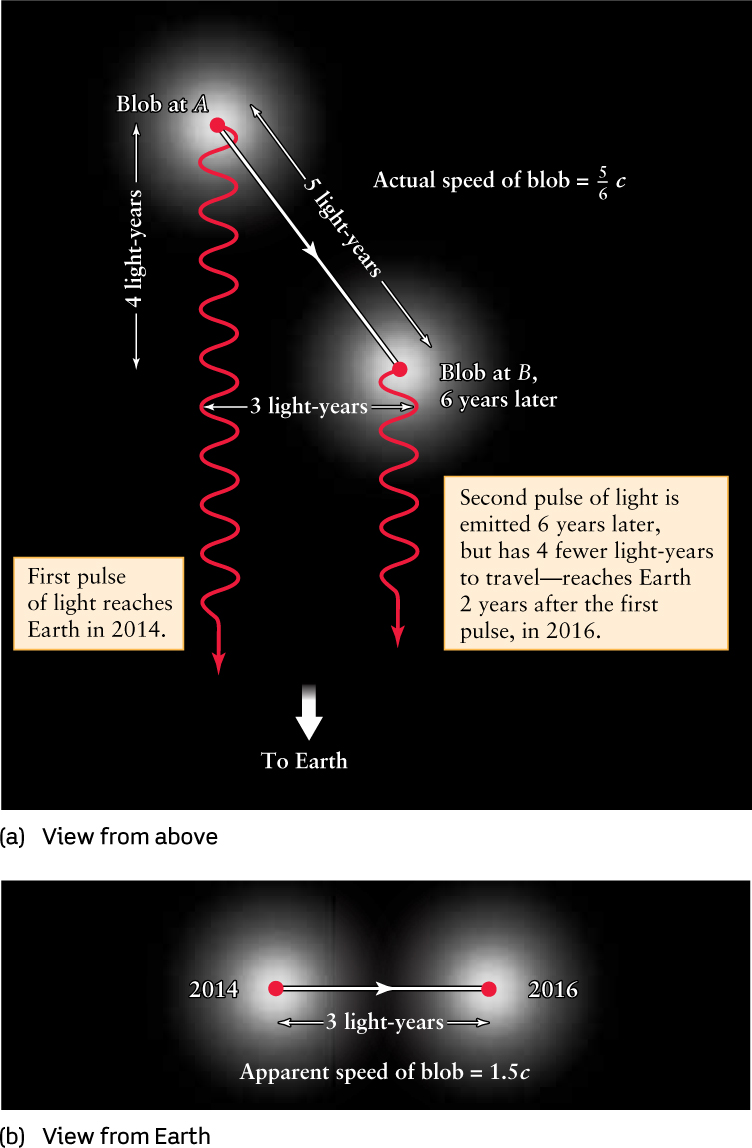
CONCEPT CHECK 24-6
In Figure 24-11, a bright blob appears to move faster than the speed of light by traversing a 3-ly distance across the sky in only 2 light-years. How far did the blob actually travel, and how long did it take?
The blob travels 5 light-years (even though we see only the 3 light-years of its sideways, transverse motion). The blob takes 6 years to travel this distance (and it travels slower than the speed of light).